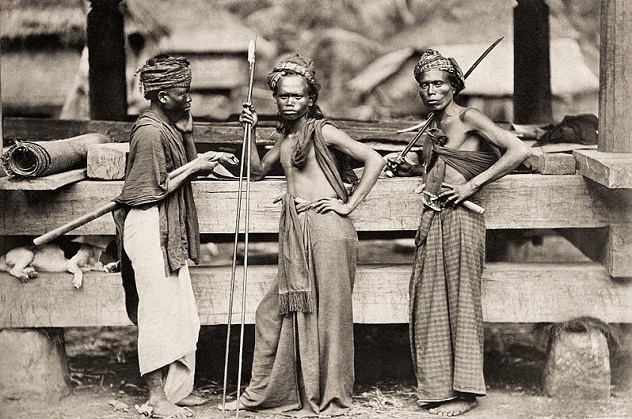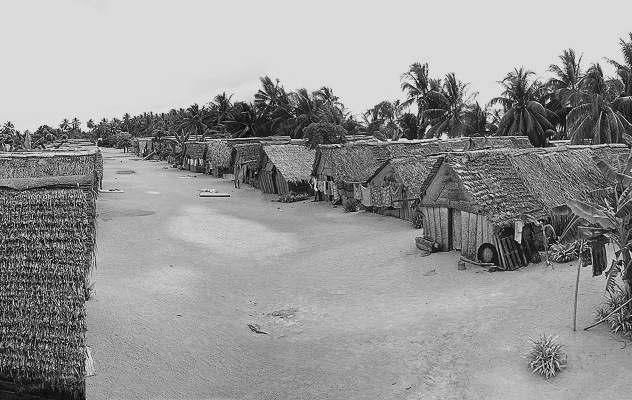 Crime
Crime  Crime
Crime  Technology
Technology 10 Hilariously Over-Engineered Solutions to Simple Problems
 Miscellaneous
Miscellaneous 10 Ironic News Stories Straight out of an Alanis Morissette Song
 Politics
Politics 10 Lesser-Known Far-Right Groups of the 21st Century
 History
History Ten Revealing Facts about Daily Domestic Life in the Old West
 Weird Stuff
Weird Stuff 10 Everyday Products Surprisingly Made by Inmates
 Movies and TV
Movies and TV 10 Actors Dragged out of Retirement for One Key Role
 Creepy
Creepy 10 Lesser-Known Shapeshifter Legends from Around the World
 Animals
Animals 10 Amazing Animal Tales from the Ancient World
 Gaming
Gaming 10 Game Characters Everyone Hated Playing
 Crime
Crime 10 Terrifying Serial Killers from Centuries Ago
 Technology
Technology 10 Hilariously Over-Engineered Solutions to Simple Problems
 Miscellaneous
Miscellaneous 10 Ironic News Stories Straight out of an Alanis Morissette Song
Who's Behind Listverse?

Jamie Frater
Head Editor
Jamie founded Listverse due to an insatiable desire to share fascinating, obscure, and bizarre facts. He has been a guest speaker on numerous national radio and television stations and is a five time published author.
More About Us Politics
Politics 10 Lesser-Known Far-Right Groups of the 21st Century
 History
History Ten Revealing Facts about Daily Domestic Life in the Old West
 Weird Stuff
Weird Stuff 10 Everyday Products Surprisingly Made by Inmates
 Movies and TV
Movies and TV 10 Actors Dragged out of Retirement for One Key Role
 Creepy
Creepy 10 Lesser-Known Shapeshifter Legends from Around the World
 Animals
Animals 10 Amazing Animal Tales from the Ancient World
 Gaming
Gaming 10 Game Characters Everyone Hated Playing
10 Tribes That Are The Last Of Their Kind
In a world where it seems like everyone is living by the clock, working for more stuff, and permanently attached to their cell phones, there are a few groups of people who live a nature-centered life, just as they did centuries ago. Climate change and modern encroachments have caused some of their populations to dwindle, but for now, these 10 tribes are still here.
10The Kayapo

The Kayapo are a Brazilian tribe that lives along the Xingu River in 44 separate villages linked by barely visible trails. They call themselves Mebengokre, which means “people of the big water.” Unfortunately, their “big water” is about to change drastically, as the enormous Belo Monte Dam—which is currently being constructed on the Xingu—nears completion. At 668 square kilometers (258 sq mi), the reservoir will flood 388 square kilometers (150 sq mi) of forest, which will not only displace many Kayapo but also harm the fish and vegetation they depend on.
The Kayapo have battled infiltration from modern man for centuries. They’ve contended with everyone from hunters and trappers to loggers and rubber tappers. They even successfully prevented the construction of a major dam in 1989. At one point, their population was down to only 1,300 but has since grown to nearly 8,000. Today, the bigger question is not if the people will survive but if their culture can stay intact. Tribe members—who are known for their elaborate body painting, farming, and colorful headdresses—are now just as likely to be seen driving motorized boats, watching TV, or even logging onto Facebook.
Did giants once walk among us? This is one ancient tribe you wouldn’t want to cross. Buy Lost Race of the Giants: The Mystery of Their Culture, Influence, and Decline throughout the World at Amazon.com!
9The Kalash

Situated in the Pakistani mountains, bordering the Taliban-controlled region of Afghanistan, is a most unusual tribe of white, European-looking people known as the Kalash. Many of the Kalash have blond hair and blue eyes, an appearance which stands in stark contrast to their darker-skinned neighbors.
Not only do the Kalash differ in physical appearance, they have a vastly different culture from the Muslims who surround them. They are polytheistic, have a unique folklore, produce wine (which is forbidden in Muslim culture), wear brightly colored clothing, and give much more freedom to women. They are a decidedly happy, peace-loving people who enjoy dancing their way through numerous yearly festivals.
No one knows for sure how this light-skinned tribe came to exist in remote Pakistan, but the Kalash claim they are long-lost descendants of Alexander the Great’s army. DNA evidence shows they had an infusion of European blood during the time of Alexander’s conquests, so it’s possible their tales are correct.
Throughout the years, surrounding Muslims have persecuted the Kalash and forced many to convert to Islam. Today, there are only about 4,000–6,000 Kalash left, who subsist largely on pastoral farming.
8The Cahuilla

While Southern California is typically associated with Hollywood, surfers, traffic, and wannabe actors, nestled within the region are nine Native American reservations inhabited by the ancient Cahuilla people. They have lived in and near the Coachella Valley for over 3,000 years and are believed to have settled there when the prehistoric Lake Cahuilla was still in existence.
Despite facing disease, the gold rush, and persecution, this tribe has managed to survive, though its membership has dwindled to just 3,000. They’ve lost much of their heritage along the way, and their unique language is on the brink of extinction. This dialect—a blend of Ute and Aztec languages—is only spoken by about 35 middle-aged or elderly members. Currently, elders are working hard to pass on their language, “bird songs,” and other cultural practices to younger generations. Like most indigenous people of North America, they must tackle the challenge of fitting in with the broader community while holding onto their old traditions.
7The Spinifex

The Spinifex, or Pila Nguru, are an Aboriginal people who have lived in the Great Victoria Desert—one of the harshest inhabitable climates—for at least 15,000 years. Even after the Europeans settled in Australia, this tribe was mostly left alone, since they occupied such a dry, inhospitable environment. That changed in the 1950s, however. The Spinifex’s land wasn’t worth stealing for agriculture reasons, but outsiders found another purpose for this barren landscape—nuclear testing.
In 1953, the British and Australian governments detonated nuclear bombs in the Spinifex’s homeland without consent and with little warning. Most of the Aboriginals were relocated to missions and didn’t begin migrating back to their homeland until the late 1980s. Upon their return, they faced an uphill battle to legally reclaim the area as their own. Interestingly, their beautiful artwork, which records their deep connection to the land, helped to secure them a Native Title Claim in 1997. Their solo and group artwork has gained mass acclaim, appearing in art exhibitions all over the world. While it’s hard to determine how many Spinifex are still scattered about, one of their largest communities, known as Tjuntjuntjara, has a population of around 180–220 people.
6The Batak

On Palawan Island in the Philippines live the Batak people, a tribe of some of the most genetically diverse humans on the planet. They are believed to belong to the Negrito or Australoid race, which are the most distantly related humans from Africans, the race from which we all originated. This means they are descendants of one of the first groups to leave Africa around 70,000 years ago, and it’s believed that they traveled from the Asian mainland to the Philippines approximately 20,000 years later.
Typical of Negritos, the Batak are small in stature and have kinky, woolly hair. Traditionally, the women wear sarongs, while the men cover themselves with nothing but a G-string and possibly feathers or jewelry. The whole community works together to hunt and gather, and they often celebrate by dancing to the beats of their homemade drums. Overall, they are a shy, peaceful people who prefer to hide deep in the jungle rather than deal with confrontation from outsiders.
Like so many other indigenous tribes, disease, land seizure, and other modern encroachments have decimated the Batak population. Currently, there are only approximately 300–500 members left. Ironically, one the biggest threats they now face is environmentalism. The Philippines government has banned deforestation in certain protected areas, which seems like a good thing, but the Batak traditionally practice slash-and-burn agriculture, a custom that is now forbidden. Unable to effectively grow their food, many are suffering from undernourishment.
5The Andamanese
 The Andamanese are also classified as Negritos, but because of their extremely short stature—adult men are shorter than 150 centimeters (4’11”) tall—they are usually referred to as pygmies. They inhabit the Andaman Islands in the Bay of Bengal and are the only people outside of Africa to display steatopygia, an excessive development of fat on the buttocks of women. Like the Batak, they are believed to have been one of the first groups to migrate out of Africa, and they developed largely in isolation until the 18th century. They didn’t even know how to make fire until the 19th century.
The Andamanese are also classified as Negritos, but because of their extremely short stature—adult men are shorter than 150 centimeters (4’11”) tall—they are usually referred to as pygmies. They inhabit the Andaman Islands in the Bay of Bengal and are the only people outside of Africa to display steatopygia, an excessive development of fat on the buttocks of women. Like the Batak, they are believed to have been one of the first groups to migrate out of Africa, and they developed largely in isolation until the 18th century. They didn’t even know how to make fire until the 19th century.
The Andamanese are divided into separate tribes, each of which has its own cultures and language. One group, the Bo, went extinct when its last surviving member died at the age of 85 in 2010. Another group, the Sentinelese, have so violently resisted outside contact that even in this technological age, very little is known about them.
Those who haven’t integrated into the larger Indian culture still live much like their ancestors. For instance, they use a single type of weapon—the bow and arrow—to hunt pig, turtle, and fish. Men and women work together to gather roots, tubers, and honey, and they regularly sing songs during their labors. Apparently, their lifestyle is working for them, as outside physicians have judged their health and nutritional status as “optimal.” The largest problems they have are the result of Indian settlers and tourists who push them off their land, bring in disease, and treat them like animals in a safari park. Although the exact number isn’t known, since some still live in isolation, it’s estimated there are roughly 400–500 Andamanese in existence.
Where do fact and fiction part ways? Find out in the thrilling sci-fi novel The Lost Tribe at Amazon.com!
4The Piraha

Although there are many small, primitive tribes sprinkled throughout Brazil and the Amazon, the Piraha are especially fascinating because they have a culture and language unlike any other people on the planet. As we’ve mentioned before, the Piraha language has some bizarre features. It has few sounds, no colors or numbers, and no past tense conjugation or subordinate clauses.
While some might call this language simplistic, these idiosyncrasies are the result of the Piraha’s values, which include living in the moment. Furthermore, because they live entirely communally, they have no need to count or ration supplies. A lot of unnecessary language is eliminated when you have no history, don’t have to keep track of anything, and only trust what you can see.
Overall, the Piraha differ from Westerners in almost every way. They’ve wholeheartedly rejected the messages of missionaries—not a single one of them has converted—and they are thoroughly unimpressed with our technology. They have no leader and share none of our sexual hang-ups. In fact, they think nothing of swapping sex for needed resources from other people or tribes. Even after hundreds of years of outside contact, this band of 300 has stayed mostly unchanged since ancient times.
3The People Of Takuu Atoll

The people of Takuu Atoll are Polynesian in origin but are considered one of the “outlier cultures,” since they live in the Melanesia region instead of the Polynesian triangle. Takuu Atoll has an especially distinct culture, which some say is more traditionally Polynesian than similar peoples. This is because the Takuu are extremely protective of their way of life and leery of outsiders. They even enforced a ban on missionaries for 40 years that wasn’t lifted until this century.
They still live in traditional thatch houses and tell stories that predate European contact. Unlike most of us, who spend the bulk of our days working, the Takuu devote 20–30 hours a week to singing and dancing. Amazingly, they have over 1,000 songs, which they repeat from memory. Their 400 or so members are all somehow related, and they are all governed by one chief.
Sadly, climate change may destroy the Takuu way of life, as the ocean may soon overtake the island. Rising sea levels have already contaminated their freshwater table and flooded crops, and it may soon become impossible to live there. Although the community has built up seawalls, they are proving ineffective, and permanent relocation plans are currently being discussed.
2The Dukha

Most of us think of reindeer as fanciful creatures that pull Santa’s sleigh, but for the Dukha, they are necessary for survival. The Dukha are Mongolia’s last group of nomadic reindeer herders, with a history dating back to the Tang dynasty. There are fewer than 300 Dukha remaining, yet they stay in their frigid homeland out of love as well as fear that their sacred snow forest, which they believe holds the ghosts of their ancestors, would die if they were to leave.
There are few resources in this cold, mountainous region, so the Dukha rely on reindeer for milk, cheese, transportation, hunting, and attracting tourists. However, like so many small tribes, the Dukha’s lifestyle is in jeopardy, as the reindeer population is rapidly declining. There are a variety of factors contributing to this decline, but the biggest sources are over-hunting and predation. Making matters worse, the discovery of gold in northern Mongolia brought miners into their land, further compromising the local wildlife. With so many challenges, many young people are abandoning their ancient ways for life in the city.
1The El Molo

The centuries-old El Molo tribe of Kenya is the smallest tribe in the country and faces threats from seemingly every direction. Due to nearly constant harassment from other groups, they have already isolated themselves on the remote shoreline of Lake Turkana, yet they still can’t seem to catch a break.
The El Molo, whose name translates to “those who make their living from other than cattle,” depend solely on fish and water animals for survival and trade. Regrettably, their lake is evaporating at a rate of 30 centimeters (12 in) per year. This has made the water more alkaline, concentrated pollutants, and reduced fish populations. It now takes them a week to catch the same number of fish they previously caught in one or two days, and they have to venture farther out into crocodile-infested waters to get them. There is fierce competition for the fish, and if matters grow worse, the El Molo could easily experience invasion by warring neighboring tribes.
On top of these environmental hazards, the El Molo suffer from cholera outbreaks every few years, which wipe out most of their very old and young citizens. Considering that the average El Molo life expectancy is only 30–45 years, that doesn’t leave many people to grow the population. Their numbers are down to about 200, and anthropologists estimate only about 40 of those are “pure” El Molo.
Content and copywriter by day and list writer by night, S. Grant enjoys exploring topics that are bizarre, unusual, and hiding in plain sight. Contact S. Grant here.








